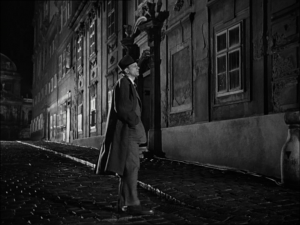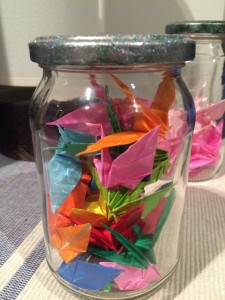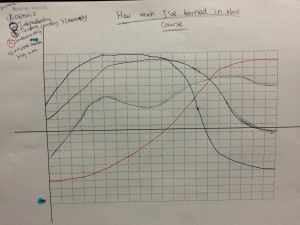So… cinema studies has been interesting. A lot had been going on, just that I haven’t really post anything here about it :/ Though one main assignment is our group project to present a blockbuster popular movie of our own choice and explore its contents and ideas. Thus, Hanna, Olivia, Monaliza and I, being in a group, chose The Blair Witch Project, 1999 by Eduardo Sanchez and Daniel Myrick. Based a realistic style and processes, both directors had filmed these infamous actors in a real-world setting and actually deprived them of food. This is to create the more natural realistic film, where audience might have even thought of the film as being a series of found-footage of the Blair Witch. Moreover, these actors are carefully chosen from new infamous actors to encourage more of the make-belief these people really got lost in the woods kind of thing.
Author: Gloria T
Shifts Towards the “Outside the Boxes”
Our week six studios focuses on the 3D cinema and the exploded frame. The Lumiere brothers had been known for experimenting with 3D cameras and cinematography. The first ever public screening of a 3D cinema was in 1922 with a film called The Power of Love. But the future becomes the present in a blink of an eye even since the 1950s. 3D films got popular then until during 1989 and on with films such as Back to the Future as well as Jaws but the popularity eventually died. 3D framing acts as the invisibility of style where as it was introduced, made popular and that trend was the shelved to be applied again even in the recent contemporary world of the cinema. These new introduction of new kinds of cinema is a progression within its history. Just like the French New Wave and the New Hollywood that eventually died, even if it’s invisibility of style remains, because they themselves causes the new emerging genres and the Blockbuster. Each film style influence each newer ones and inspire new younger directors. To link these shifts to 3D as Dan mentioned, “all cinema is about optical perception and our comprehension of space” and these different cinematic styles are evolving towards the 3D experience that had shifted as a result of experimentation of new technologies and thinking outside the box.
What had blew my mind about this week’s inspirations is the screening of partly documentary-short narrative feature This is Not a Film by Jafar Panahi. With all the restrictions and government banning him to ever direct a movie or even write his films and internet websites blocked, he opened my mind to a whole new dimension of thinking outside the box. “What if when we can’t show a film, we tell a film?” Panahi demonstrated his idea of an unmade film in this piece using his living room and tape to “draw” the set, acting out his characters and describing his screen play. What he had done not only inspire me as a media practitioner but motivate me to be unique as films within the cinema is evolving and where cinema is heading.
Break? What break?
Like there is such thing as semester break in this course. Week 6 is more like a catching up-week in addition to new projects due. To do list:
- Creative Advertising portfolio; mostly work on the rationale
- On the Frame project brief 3; 2000-word Proposal
- Popular cinema: watch Blair Witch Project…
On the bright side, I finally get to see my first musical in Melbourne. Who wouldn’t want to see The Lion King musical hey? Being produced in Regent Theatre, the musical got me thinking about our On The Frame studio and how its staging aesthetics, costume design and basically the whole miss-en-scene plays an important role in a musical set design. Julie Taymor’s design of the African-style costumes, wooden lion masks, Soweto choral singing and aesthetics inspired from Indonesian shadow puppetry are complemented to show the indigenous life on stage. The Lion King south african co-creator, Lebo M insisted that most of the cast must be South African to inhibit the performance with bright spirit that encourage a fresh energy within the musical production. Furthermore, with the use of African languages such as Swahili in the song “Hakuna Matata” and Zulu in “Circle of life”, the overall dialogue and music gives the african life tone that signifies the setting and context of the production.
On The Frame studio allows us to explore Deleuze’s idea of out of field in which refers to what is not seen on the frame but is still considered or understood. When I was viewing The Lion King, I’ve noticed characters entrances not only from the back stage but behind our exit doors coming from our side. This entrance have significantly reflected the idea of ‘out of field’ and that what is understood not necessarily should be seen on the frame. Not only provoking the 3D sense that goes beyond the stage, the use of space among the audiences also invites them into the diegesis of the musical. It is because the production surrounds the audiences to be part of the experience whilst giving the realistic feeling of connection to the narrative.
Thinking Film…
What? Can film think?
As funny as it sounds, film does have subjectivity and acts as the vision of the filmmakers. Dziga Vertov explored the idea that the camera (or medium) is an extension of the human body. It’s as if we can speak to those on the other side of the world through film. Film elaborates on specific ideas based on the context of the filmmaker while communicating with the viewers. And viewers experience those perspectives through the medium. Filmic codes and conventions and styles reflect the context in which the film is made. We would see digitalised frames with CGI effects in films made in the contemporary modern world full of technological innovations such as The Matrix. There are the point of view, empathy and subjectivity not only within the film, but the whole world of cinema. Dan explained during our studio that “Film is not of a world, it is a world with its own intentions”. Therefore, we as viewers have our perception yet film itself have a perception of its world in which it lives in… other than being as a projection of our thoughts.
Well since film can think, it lives doesn’t it?
As the guy said, it’s part of our body. Like selfies! It is an extension of our own eyes to see ourselves just as Andy Warhol painted his self-portrait with his paintbrush. These cameras, lenses, brushes are all like our hands and eyes.
deleuze framing
This reproduction piece of photograph is based on a still image from the film, The Third Man, 1949. As evident, the image is of black and white and therefore the reproduction should also be a black and white image. As of the production context of the original image is during the WWII in Vienna , the reproduction is portrayed to be a modern-day or contemporary Melbourne context instead of being exactly a replica. Though, the framing, position and setting are all an imitation of the original still.
Based on Gilles Deleuze’s idea that ‘The out-of-field refers to what is neither seen nor understood, but is nevertheless perfectly present’ (p.16), I’ve made another reproduction that demonstrates the idea. The stop-motion piece shows a frame that replicates the original given frame from The Third Man, while followed by other different frames, which shows the out-of-field of the original still. In this case, what we as viewers would understand is that the subject (man) is waiting for a girl outside her window and when she shows up unexpectedly, he gets shocked. We would understand at least that he is waiting for something even before the frame of the girl is shown. Therefore, our perception and comprehension of the world outside and also inside the film means that we are able to interpret the film based on how our world (in the out-of-field) works.
Manipulation of Time
Our week 3 studios focuses on narrative and time. As Dan said, frame is time, not just a signifier of time. The idea that everything in the film is moving sounds a bit confusing let alone our minds respond, what about still shots on the frame? But even in stills, time is moving. In terms of narratives, having either plots that moves forward or flashbacks or jumbled up in different chronology, the story still begins and ends in linear order. That is the difference between a plot and a story, which in my popular cinema seminar I’ve learned two new vocabularies identifying these two conventions. These includes Fabula (or story) which can be defined as the purpose and meaning of the whole narrative, and Syuzhat (or plot) which is the order that the story is presented.
We are able to manipulate time through filmic codes and conventions including the popular technique of flashbacks. If we see a shot or a scene that is framed in a different colour, hue, filter or even sound than other scenes, as viewers we interpret this distinguishable content as a different part of the narrative. Another technique of time-manipulation is the use of slow-motion movement that is developed into a more advanced mobile movement called the bullet-time.
Photography is about framing
When thinking about frames, my mind automatically visualise the physical outskirts of an image. But this week, I’ve learned that framing means much more deeper than that. It is also about the image composition itself and how an image is constructed the way it is through visual codes. It is just what we are doing when taking a photograph. From the readings that we did for this week, my favourite quote from the readings so far is that “Photographs alter and enlarge our notions of what is worth looking at and what we have a right to observe” (Sontag). We all have different perspectives on each certain image and it is up to us how we interpret those visual compositions. “They are a grammar and more importantly and ethics of seeing”. With this being said, framing acts as a guidelines and a “position of thinking” (Frampton, 2006). Therefore, while working on my 50 frames in this week 2, it has implanted in my mind that the subjects in my photographs has an allegory. For example, the photograph of the origami jar that I took may be interpreted that the artist of the origami is Japanese, having it originated from Japan. But it can also mean that a passionate origami maker, not necessarily from Japan, has created the colourful mixture of origami papers. Its allegory also leads into a perception that it is about a journey of a person who loves colourful and brightness life setting.
I’m Back In
For the past month Perth was 20 degrees C even in its winter. It was homey, it was fresh, it was fun. Perth was nice. And now back to Melbourne, with its almost-everyday-cloudy gloomy weather during the winter.
First day of Creative Advertising lecture on monday was quite chill. Thank God it was just one hour. But the following days of this week have left me dozed off thanks to the wonderful pain of chills given from the winter’s temperature and the wind. Well hang on, this will totally help; knowing that assignments are starting to be due the following week. So like it or not I’ll have to stay awake. Okay I’m exaggerating too much here and on the bright side, we are going on an excursion to the National Gallery of Victoria this thursday for our On The Frame studio. At least that’s what making me excited at the start of this semester. Furthermore, meeting past colleagues from the last semester as well as new mates gave me a boost this first week.
Last But Not Yet the End
My Learning Graph
How much I’ve learned in this course…
- Green– How much is learnt about making media objects/stories
- Blue– Ability to work independently in unfamiliar ways/systems/new tools
- Black- Thinking critically and creatively
- Red– Understanding of the role media blog to me
The Top 5
The Satirical New & Old iPhone
Final Reflection So Far
Here I am posting this last blog this semester. Wow! This semester went so fast as in a blink of an eye. I have learned so much, ominously, especially having a little knowledge in media production. I have taken media courses in high school, but definitely not one of the best students in class. However, being able to choose breadth or different courses relating to our own interest has motivated me significantly throughout the semester.
Learning broader and deeper concepts in Cinema Studies course has developed my previous knowledge about the world of cinema. Watching The Wizard of Oz, experimental films like Koyaanisqatsi, or even learning mise-en-scene and shot aspects might be a little repetitive. But having discovered great films and filmic terms that I’ve never heard before has been one of the most things I’m interested in. Hence, my passion in the cinema world. Media, being a 24-point course started off nice and easy. As experimental and abstract style has been my primary interest in filmmaking, I decided to base by first two project briefs with an ambiguous sense of content and was quite happy with my brief #3. Despite that I was already getting a hang of editing in iMovie, producing these two short films has made me learn heaps amount of techniques as well as being inspired by what was obtained from Cinema Studies. And when I think of it (having a light-bulb moment here), all these courses I’ve done are all connected. Last of but not least, Popular Culture explores substantial amount of ideas about social networking, music videos or films that are relevant to the Media and Cinema Studies. Plus, I’ve undergone at least one group work in each of the courses while annotated bibliography appeared in two of these courses. Seems to me that Media & Communication is like a spider web, each strand having similar characteristics yet in different placements.
Being a mostly hyper-attentive learner, I don’t learn well in silence or should I say “less noises”. I watch and observe, communicate to get ideas and need some breaks once in a while. During the semester, getting ideas presented in my projects required me to go out and explore the world while collecting inspirations. As Rachel had mentioned in our Lectorials it is important to “notice” what’s surrounding us, I noticed that our break is coming real soon and very excited to “ideas-shopping” for the next coming semester.
What were the most challenging aspects of this course? I found that getting out there and present my work (and myself) to the crowd is nerve-wrecking. Confidence had been the challenge in every presentation that I did even when I’ve somehow overcome it previously. But throughout all the courses in this semester, having done video logs, group presentations and individual film performances had helped an improvement on my courage.
I’m sure that we’ve all done this somewhat regularly in producing a media artefact. Sometime we have started off blank and have no idea whatsoever, not even really know how to use a movie editing software. It surprises me though, that of all those “light-bulb” moments of creativity came mostly accidental. I’ve always wondered how a split screen is complemented and yet, discovered that vertical split screen can have an overlapped shots horizontal with a vertical shot (as complemented in Brief #3). Therefore, creativity not only comes from inspirations and a remix of those ideas but also accidents in experimental techniques.
Reflection time…
Brief 4, “Media Idea” Reflection
These couple of weeks have been the busiest and tiring time of the semester as my group and I worked through our brief four media artefact. Despite all the hard, time-consuming work, we have all managed to get everything up together and finished our audio documentary piece. I was one of those people who actually liked setting up google-docs and groups in Facebook. I thought we have been really organised with our management and with the help from both Bianca and Patrick, our team finished on time by the due date. One of the most successful achievements is the texture of the piece presented by adding a diverse range of varied different sounds. Bianca did a really great job in delivering her narration throughout the podcast while her voice is extraordinary in its tone. I’ve also felt grateful and relieved that my contribution by narrating the quotes is a success that I did not expect, from having a soft voice at times. Patrick had been very professional in editing and even had taught me valuable skills in audio editing using the pro tools editing software. Furthermore, these contributions are possible because each one of us tried to make ourselves available even in the distractions from other course projects. Especially when we were all present to record Bianca narrating in the sound-proof studio in building 9, our home of media and communication. Continue reading








